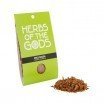Don't have an account?
Register NowYou have to add to cart at least 5 bottles or any program to make checkout.
- BlogDamiana: The Aphrodisiac And Relaxant Herb Of The Mayans
Damiana: The Aphrodisiac And Relaxant Herb Of The Mayans
Published: November 30th, 2018
Coming from the Greek word “daman” meaning “to tame or subdue”, damiana is an herb with a long history. With its deepest roots in Central and South America, this herb was used by the Mayans and Aztecs as a natural aphrodisiac and relaxant.
But what really is this mysterious herb that’s been around for more than 4,000 years? And why have so many still not heard of it?

WHAT IS DAMIANA?
Native to South and Central America, damiana is a small shrub that produces yellow and beautiful flowers. It’s the leaves and stems of these flowers that can be used in different ways to extract the plant’s properties.
Through various methods, damiana consumption can act as an antidepressant and general mood-elevator. Although there isn’t enough evidence, it has been noted that the relaxing effects of damiana are both physical and mental. The herb demonstrates its physically relaxing properties by increasing oxygen in the blood. This helps keep the overall body relaxed, improving mental state and sexual aptitude.
Although studies on rats have proven damiana’s aphrodisiac properties, human studies are still lacking. But we do know that damiana is full of antioxidants, caffeine, and essential oils, amongst other intriguing constituents. Let’s dive deeper into how these act on the body.
WHAT DOES DAMIANA DO?

A damiana tea is a great way to help with symptoms of depression, insomnia, nervousness, and anxiety. It’ll mostly help combat the physical symptoms, which in turn will help alleviate the mind. It relaxes muscle tension, yielding greater comfort when suffering from headaches, fatigue, and muscle pain, as well as helping with digestion and overall sexual drive.
Although not yet certain, it’s believed that caffeine, arbutine, and flavonoids are the compounds in damiana responsible for the increased sex drive. These are said to improve libido and also help with sexual dysfunction in both males and females. All of this in combination with the energy and mood boost, as well as the relaxing properties of the plant, make it the perfect recipe for a healthy and enjoyable sex life.
But this is definitely not the only use of damiana. It has been observed that a mixture of a few different herbs including damiana can help people lose weight by decreasing appetite, stimulating physical exercise with the added energy, and even by reducing stress-induced eating. And on top of this, according to the Journal of Ethnopharmacology, damiana also has antidiabetic and gastroprotective properties.
And finally, damiana is a great anti-inflammatory agent. Pinocembrin, widely present in its leaves, has been proven to have anti-inflammatory, antioxidant, and anticancer properties. This means that the herb can help treat anything from ear infections to stomach ulcers and even menopausal symptoms. A study looked at how damiana affected 108 women aged 22 to 73. All women in this study reported an increase in sexual drive—especially postmenopausal women.
WAYS TO CONSUME DAMIANA

As with most herbs, consuming a large quantity in one go will give you short-term effects, while consuming a small amount regularly will help you achieve greater, more sustained results. Regardless of the way you’re consuming it, if you want the true effects, you’ll have to stick to a method for a longer period of time. So make sure that you’re comfortable with the one you choose.
The most effective and probably most common consumption method is tea. This method will still take a couple of weeks of regular consumption for you to feel its full effects. To make the tea, place a large teaspoon of the dried herb in a cup of hot water for 15 minutes. If you want to make a large dose, add around 15 grams to a litre of hot water to steep. You can mix it with milk and/or honey for improved flavour.
If you try this and really don’t like the flavour, you can always vape or smoke the dried damiana. Vaping it at 190°C is the best solution. You can also mix it in a joint or rolled cigarette, but smoking it will obviously be the least healthy way of consuming the herb.
And finally, if you’re not a smoker and prefer the occasional alcoholic beverage, it’s fairly easy to make damiana liquor. Mix 60 grams of the dried herb with a litre of vodka and let it sit for over a week. Filter the solution after this time—first through a mesh for the main leaves and then through a coffee filter. Take the 60g of soaked damiana and place in half a litre of water for around 10 hours. Strain and filter the plant matter once again, then discard it. Warm the water slightly, add one to two cups of honey, and let it dissolve into the solution. Now, mix the water and honey with the infused vodka and let sit for 3 months. After that, all you need is to decant the liquor and you’re done.
HISTORY OF DAMIANA

Although it is known that damiana played an important role in Mayan culture, it was only in the late 19th century that it became a commercial product. It was added to the National American Formulary in 1888 and removed in 1916, but it became popular again in the ‘60s amongst hippies and ethnobotanists. It now has a permanent place and a great deal of respect in the world of plant-based medicine.
WHEN NOT TO USE IT

As with almost everything, there are always situations in which you should not consume damiana, so make sure you consult with your doctor before starting a consumption routine. It is also recommended that you stay away from the plant if you’re pregnant, breastfeeding, or have been diagnosed with diabetes. And if, despite everything, you’re still comfortable consuming the herb, make sure you’re not abusing it. Taking too much of almost anything can be harmful. And this is a plant that hasn’t been studied too deeply yet. Its abuse has been linked to liver damage and gastrointestinal discomfort. Consume it moderately and at your own risk!






